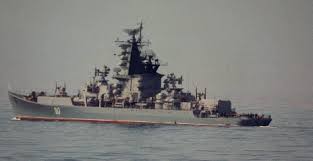Le navi del Progetto 1134 o Classe Zozulja, note in occidente come classe Kresta, hanno rappresentato una svolta nella Marina Sovietica, con un passaggio dal ruolo antinave a quello antisommergibile. La classe è costituita da due sottoclassi: la Kresta I e Kresta II.
Il progetto 1134 russo Бе́ркут, translitterato Berkut che significa Aquila reale) ha avuto ulteriori sviluppi nel Progetto 1134A o Kresta II e Progetto 1134B o Kara.
Caratteristiche
Le unità della Classe Kresta I sono sostanzialmente multiruolo tendenzialmente orientate al combattimento navale di superficie, armate di missili Shaddock in due rampe binate e prive di sistema di ricarica. Queste navi vennero classificate RKR (Ракетный крейсер; translitterato: Raketnyj Krejser) ovvero incrociatori lanciamissili.
Il loro progetto, derivato da quello dei Kynda, prevedeva un generale ingrandimento dello scafo e delle strutture, con ancora la classica sistemazione delle sovrastrutture con una certa tendenza alla forma piramidale, con un grande albero/fumaiolo a centro nave con una selva di antenne, la più importante delle quali era, alla sommità, quella di scoperta aerea Big Net.
L'apparato propulsivo era costituito da 2 turboriduttori su altrettanti assi, con potenza di circa 100.000hp che consentivano una velocità massima di 34 nodi.
L'armamento era dato da una batteria di missili SS-N-3 Shaddock, che però, rispetto alle Kynda, risultava di sole 4 armi in 2 lanciatori binati, ai fianchi della plancia. Non esistevano ricariche, per cui il totale disponibile era di appena un quarto rispetto alla più piccola classe precedente. I missili Shaddock, assai grandi e vulnerabili, in tale numero non davano certo elevate probabilità di oltrepassare la difesa delle navi occidentali. In compenso, il numero dei lanciamissili SAN-1 Goa (versione navalizzata dei missili SA-3 Goa), venne raddoppiato con 2 rampe, una a prua e una a poppa. Per il resto poche variazioni, con 2 lanciasiluri quintupli da 533mm, 2 lanciarazzi ASW RBU-6000 2 cannoni binati AK-257 da 57mm e 1 elicottero Kamov Ka-25 per la ricerca dei bersagli per missili antinave. Una delle unità, l'Admiral Drodz, ebbe anche 4 CIWS ADG-630 con 2 radar Bass Tilt abbinati.
Kresta II
Essendo cambiate le priorità della Marina Sovietica solo quattro furono le unita costruite in questa configurazione. Le successive dieci unità del Progetto 1134A, conosciute in Occidente come Kresta II, sono state concepite come grandi navi antisommergibili, e giustamente sono state classificate dai sovietici BPK (BPK: Bol'šoyj Protivolodonyj Korabl') e dal punto di vista dell'equipaggiamento simili ai Kashin.
Servizio
Le Kresta I e II hanno fatto parte della flotta sovietica in funzioni di navi antisom e di capo flottiglia, operando con tutte le flotte: nel 1983 era segnalato un Kresta I e 5 II con la flotta dell'Artico, 1 I e 3 II con quella del Pacifico, 2 I e 2 II in quella del Baltico.
Progressivamente, esse sono state soppiantate dalle classi Kara e soprattutto dai cacciatorpediniere classe Udaloy, grazie a 2 elicotteri e al sonar a profondità variabile, strumento essenziale per la caccia antisom.
ENGLISH
The Kresta I class, Soviet designation Project 1134 Berkut (golden eagle), was a class of guided missile cruiser built in the Soviet Union for the Soviet Navy. The ships were designed for a surface warfare role, but Soviet priorities were changed to an anti-submarine role and only four ships were built in this configuration. They were followed by the Kresta II class, an anti-submarine warfare variant.
Design
Though considerably larger, more effective and reliable than the previous Soviet cruiser class, the Kynda class, the Kresta I surface warfare cruisers carried only half as many Shaddock launch tubes and one-fourth the total number of missiles. Initially it was planned to fit the SS-N-12 Sandbox (P-500 Bazalt) missile but the protracted development of this missile led to the older SS-N-3 being shipped. The self-defence armament was considerably increased as were command and communications facilities.
The Kresta Is could launch four SS-N-3b SLCMs and 44 SA-N-1 surface-to-air missiles with two twin launchers fore and aft, and had ten 533 mm (21 in) torpedo tubes. A single Ka-25 Hormone B helicopter was carried for targeting the cruise missile, and mid-course corrections.
Variants
Project 934: Variant armed with eight short range anti ship missiles (SS-N-9) otherwise similar to the ships built. This design evolved into the Kresta II class.
Project 934K: This was a larger flagship variant with enlarged command facilities and a bigger hangar for four or five helicopters. This variant was cancelled.
Ships
The initial plan was for a single squadron of seven ships armed with long range missiles and two squadrons of fourteen ships armed with shorter range missiles. In reality only four ships were built before production switched to the anti-submarine variant the Kresta II class.
All the ships were built by the Zhdanov Shipyard in Leningrad.
Name
|
Russian
|
Laid down
|
Launched
|
Commissioned
|
Decommissioned
|
ADMIRAL ZOZULYA
|
Адмирал Зозуля
|
26 July 1964
|
17 October 1965
|
8 October 1967
|
15 December 1994
|
Vladivostok
|
Владивосток
|
24 December 1964
|
1 August 1966
|
1 August 1969
|
1 January 1991
|
VITSE ADMIRAL DROZD
|
Вице-Адмирал Дрозд
|
26 October 1965
|
18 November 1966
|
27 December 1968
|
1 July 1990
|
Sevastopol
|
Севастополь
|
8 June 1966
|
28 April 1967
|
25 September 1969
|
15 December 1989
|
(Web, Google, Wikipedia, You Tube)




















Nessun commento:
Posta un commento
Nota. Solo i membri di questo blog possono postare un commento.